Today, I’m sharing possibly the most classic Indian dish ever: Dal Tadka!
I grew up eating dal nearly everyday as a child (like many Indian kids!), and this version is my favorite weeknight dal recipe. It’s creamy, packed with layer upon layer of flavor, and is a warm hug in a bowl. It gets taken over the top with the spiced oil (tadka) and tastes like pure comfort food (but is healthy, vegan, and gluten-free).
And if you have my cookbook, The Vegan Instant Pot Cookbook, you can find a recipe for an easy but delicious Dal Tadka in Chapter 3.
What is Dal Tadka?
Dal = the Hindi word for lentil.
In India, dal refers not only to the dish but also to lentils themselves. The dish is basically a deeply spiced, aromatic lentil stew, but there are countless regional variations of dal and even more variations across each Indian family.
Tadka = tempered oil in which spices, herbs, and/or aromatics are briefly fried in oil. The name differs depending on the regional language. For instance, in Gujarati (the language my family speaks), we call it vaghar.
The dal (lentils cooked in spices and aromatics) is finished by pouring the tadka on top.
In this recipe, split lentils are cooked in a mixture of aromatics, ground spices, and tomatoes (which bring a pleasant tanginess) until soft and creamy. The lentils are finished with the fragrant tadka, which enhances both the taste and texture.
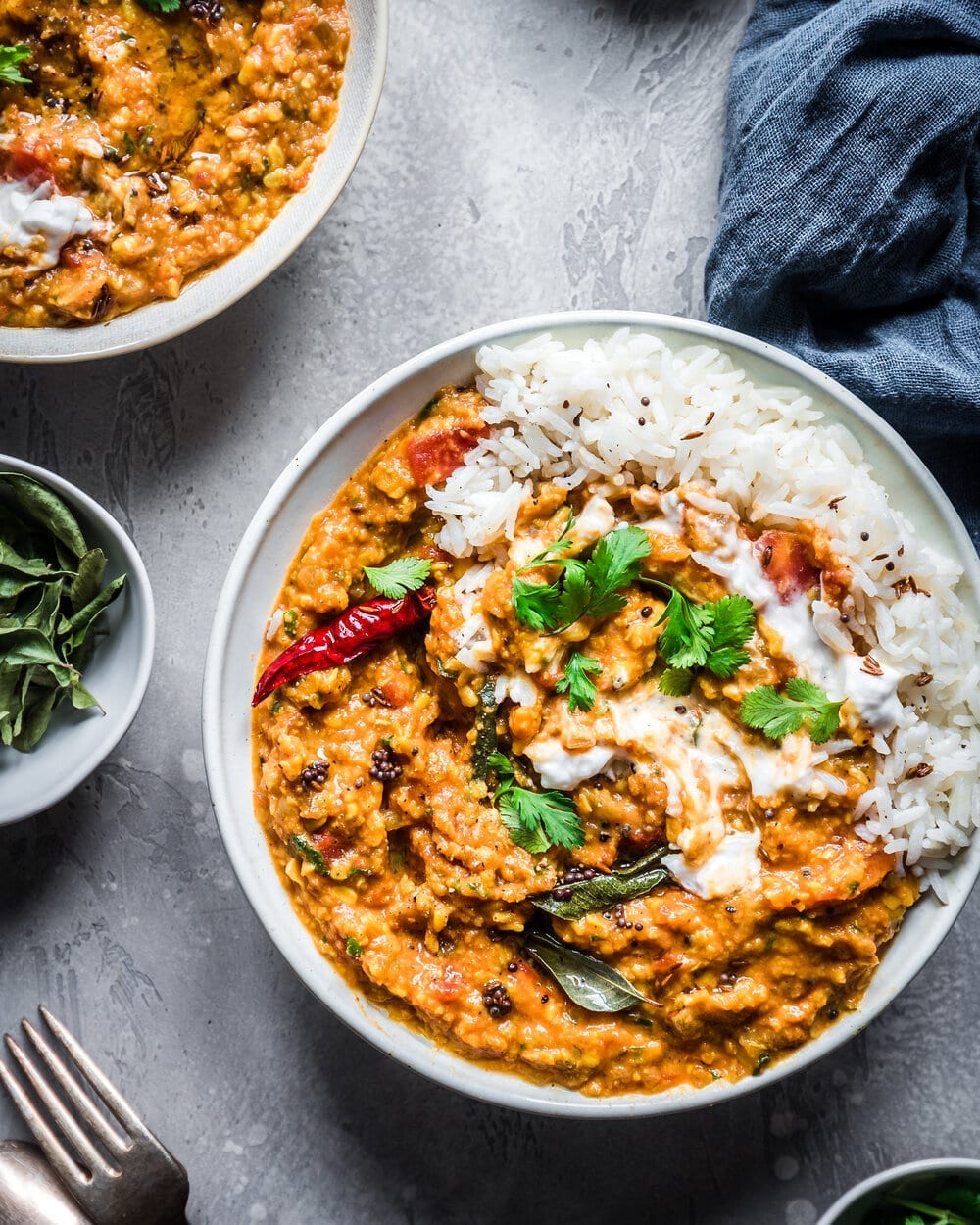
Why you’ll love this Dal Tadka
Pantry staples. Aside from a few aromatics (fresh ginger, green chili pepper, and cilantro), this is a pantry recipe!
Budget-friendly. In addition to being a pantry meal, it’s budget-friendly!
Authentic Indian food, restaurant-style. There are a ton of Indian recipes out on the internet, and a lot of them skimp on spices or just use one or two bottled spices. I can see the appeal of that, but if you want a truly authentic (and incredibly delicious) Indian dal, this is the recipe for you!
Comfort food but healthy. It’s creamy, deeply spiced and aromatic, and tastes indulgent. BUT, it’s made with wholesome ingredients and high in protein, thanks to lentils. Dairy-free, gluten-free, soy-free, and nut-free, so it’s allergen-friendly too!
What kind of lentils are used in dal?
Dal is typically made with split lentils or split peas, but there are also variations that use split chickpeas (“chana dal”) or kidney beans (“rajma dal”).
In this recipe, I use moong dal (AKA yellow split lentils), but growing up, my mom most often used toor dal (AKA yellow split pigeon peas). You can easily substitute with other split lentils. The cook time will vary, with the chana dal likely taking the longest, so you need to keep an eye on the dal as it cooks.
You can find every variety of split lentil and pea at South Asian grocery stores. If you have access to only a basic grocery store, use regular red lentils (they will take a bit longer to cook since their skins aren’t split).
You can also find these lentils on Amazon. All of these varieties work in this recipe.
- Moong Dal (yellow split lentils)
- Toor Dal (yellow split pigeon peas)
- Chana Dal (split chickpeas)
- Masoor Dal (red split lentils)
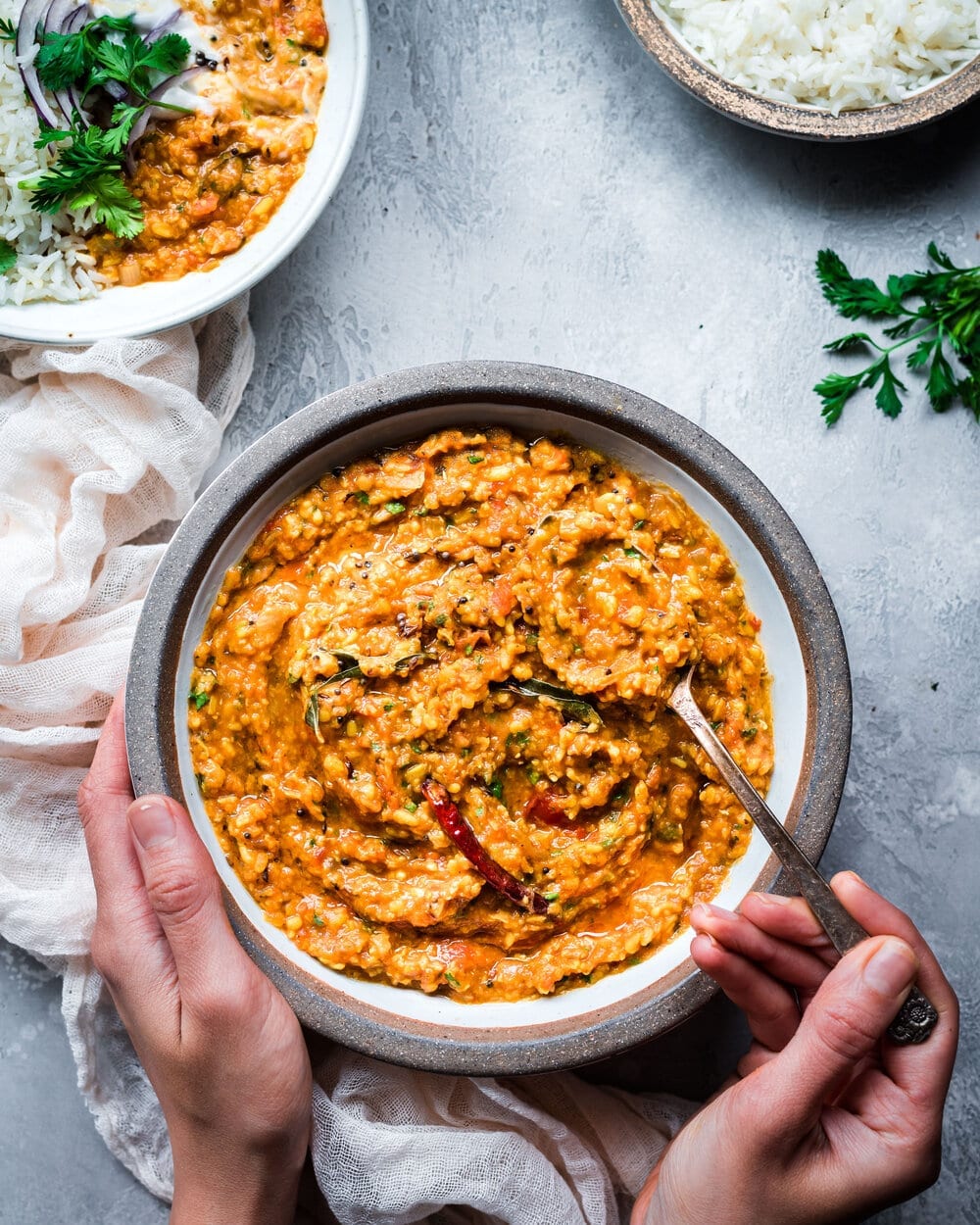
Everything you need to know about Tadka
Tadka is tempered and spice-infused oil, widely used in Indian cooking. The idea is to toast spices and aromatics in a fat source, as it releases their essential oils, which is where the aroma and flavors live.
Basic instructions for tadka
Heat up a few spoons of oil in a small pan (sometimes ghee is used, but I use oil to keep it vegan). Add whole spices and/or sliced or minced aromatics (like ginger or garlic). Toast them until they sizzle and become aromatic, swirling often to prevent burning.
If adding ground spices, add them last, for just 10-30 seconds. Stir or swirl the pan frequently to prevent burning.
Tip: The tadka brings SO much flavor and warmth to the dish (and even texture). It takes the dal from good to fantastic, so please please please don’t skip it!!
Tips for making tadka
An Indian spice tin is very handy. When you have to work quickly, it’s convenient to have all the spices in shallow, uncovered tins rather than in individual deep spice jars.
A small skillet works best, but a tadka pan is even better! It’s a tiny, deep saucepan that looks like a ladle and helps prevent the spices from jumping out of the pan.
Once your spices have released their fabulous aromas, take them off the heat immediately to prevent them from overcooking or burning.
What spices are used in tadka?
My version contains black mustard seeds, cumin seeds, curry leaves, and dried red chili pepper. I think the curry leaves and mustard seeds add the most flavor, so I wouldn’t skip those if you have an Indian grocery store near you. If you don’t, here are some dried curry leaves on Amazon.
Substitutes: If you don’t have all the spices in this recipe, fret not because every tadka is different. Here are some substitute options.
- Thinly sliced shallots or garlic
- Fennel seeds or fenugreek leaves
- Whole cinnamon sticks, broken into pieces
- Whole cardamom pods or whole cloves
- A few pinches of ground spices, such as cumin or coriander (be sure to add for just a few seconds at the very end to prevent burning)
- Asafoetida powder (aka hing) is often added to dal, as it helps the body better digest legumes. It brings all the spices together and makes it taste distinctly Indian. Note: it smells very pungent and offputting, but once cooked, its odor disappears.
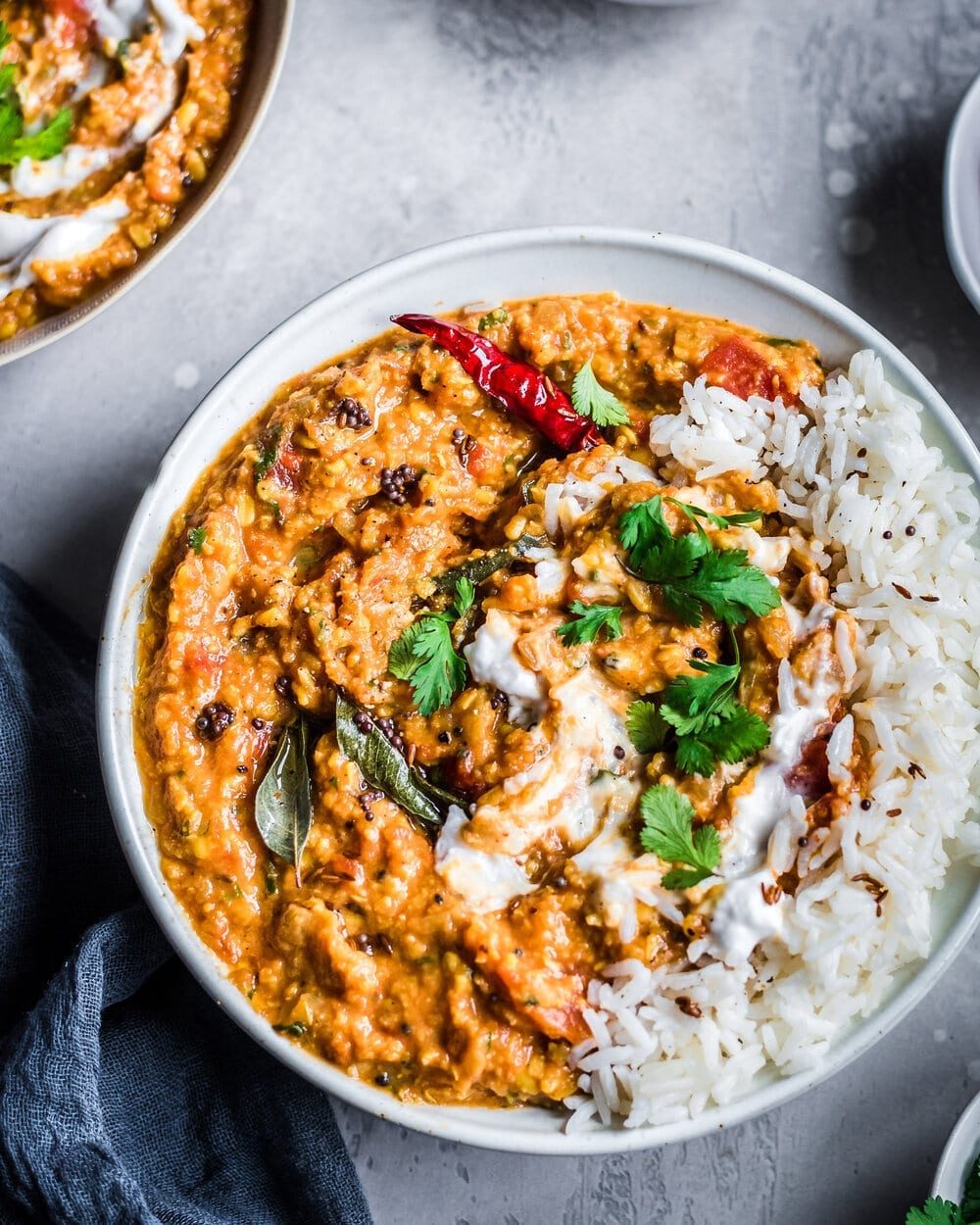
How to make Dal Tadka (step-by-step instructions)
Gather your ingredients.
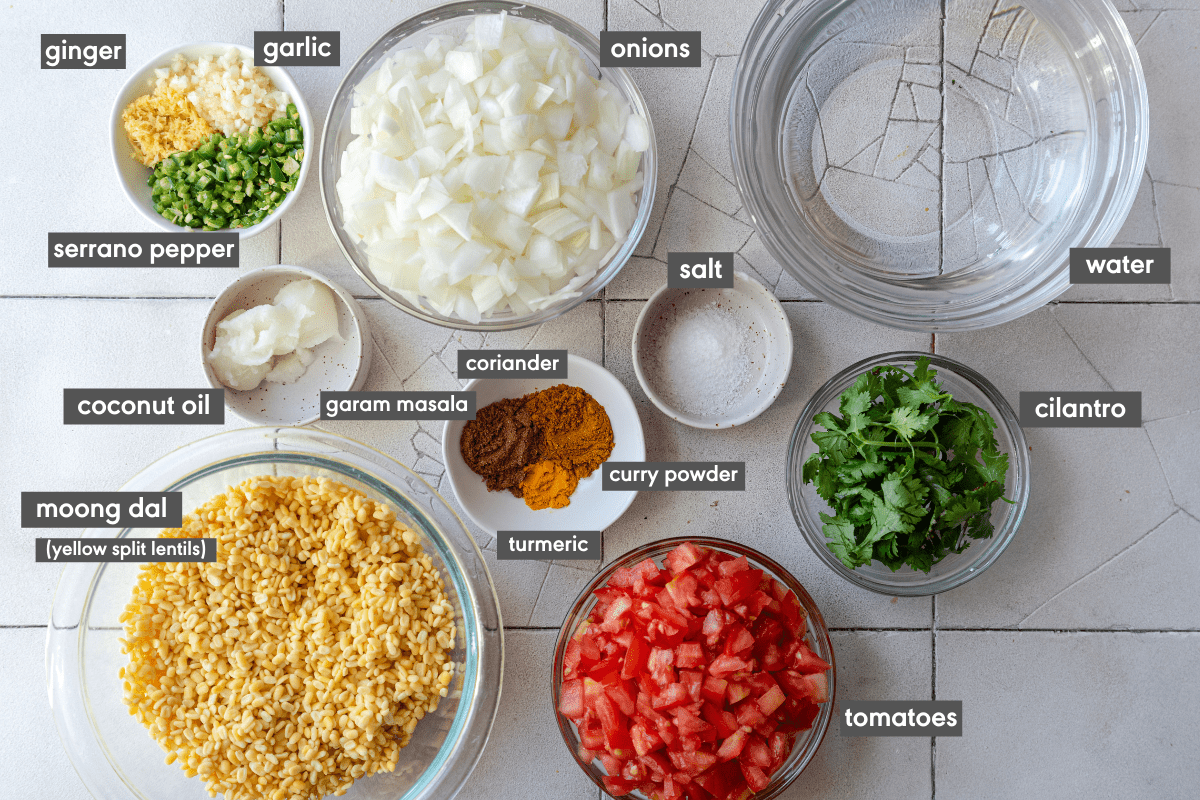
Heat a large frying pan over medium-high heat with the oil. Sauté the onions until starting to turn golden. Add the garlic, ginger and serrano pepper, and sauté for 60-90 seconds.
Add the ground spices and stir almost constantly for 30 seconds. Pour in 2 cups water to deglaze the pan, scraping up the browned bits.
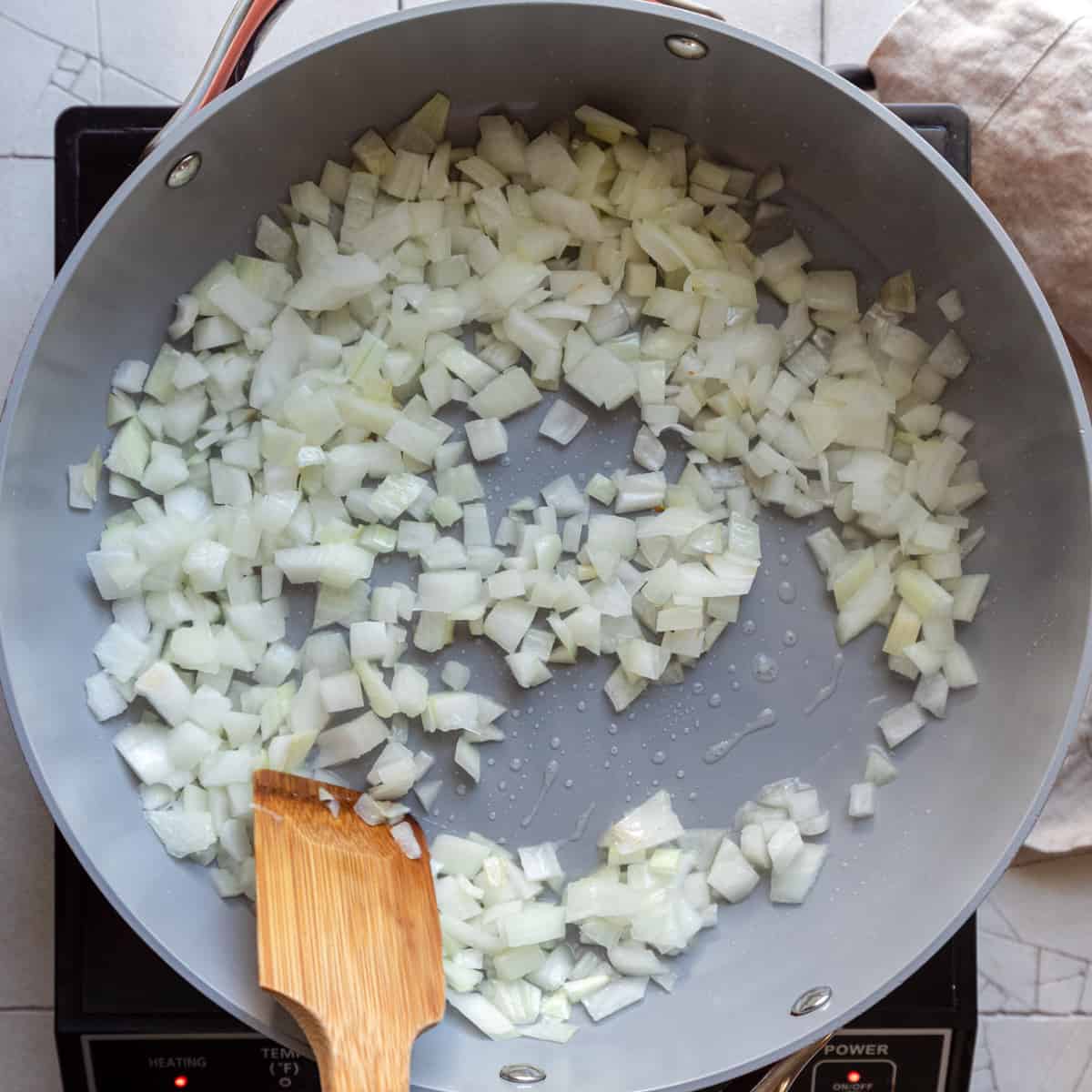
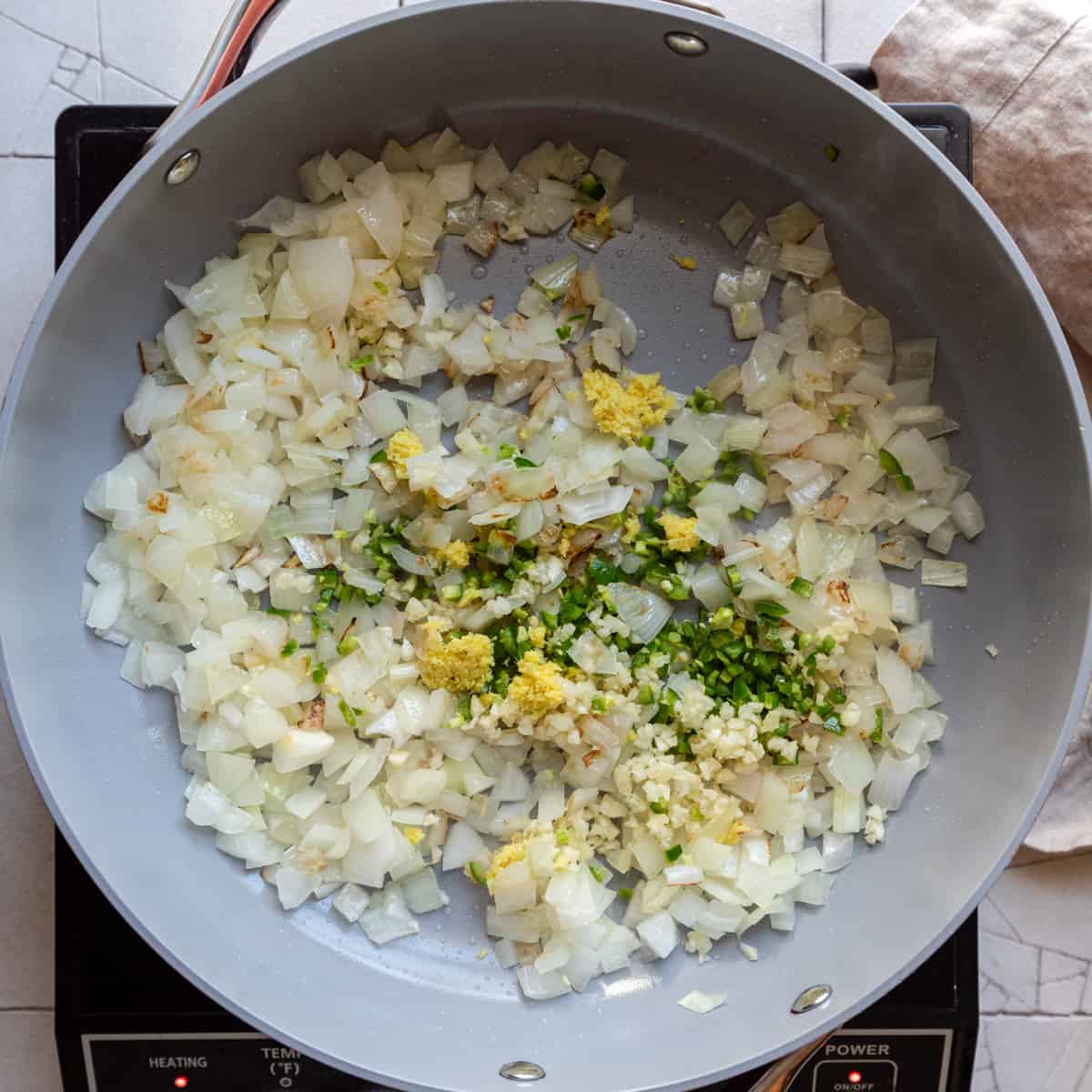
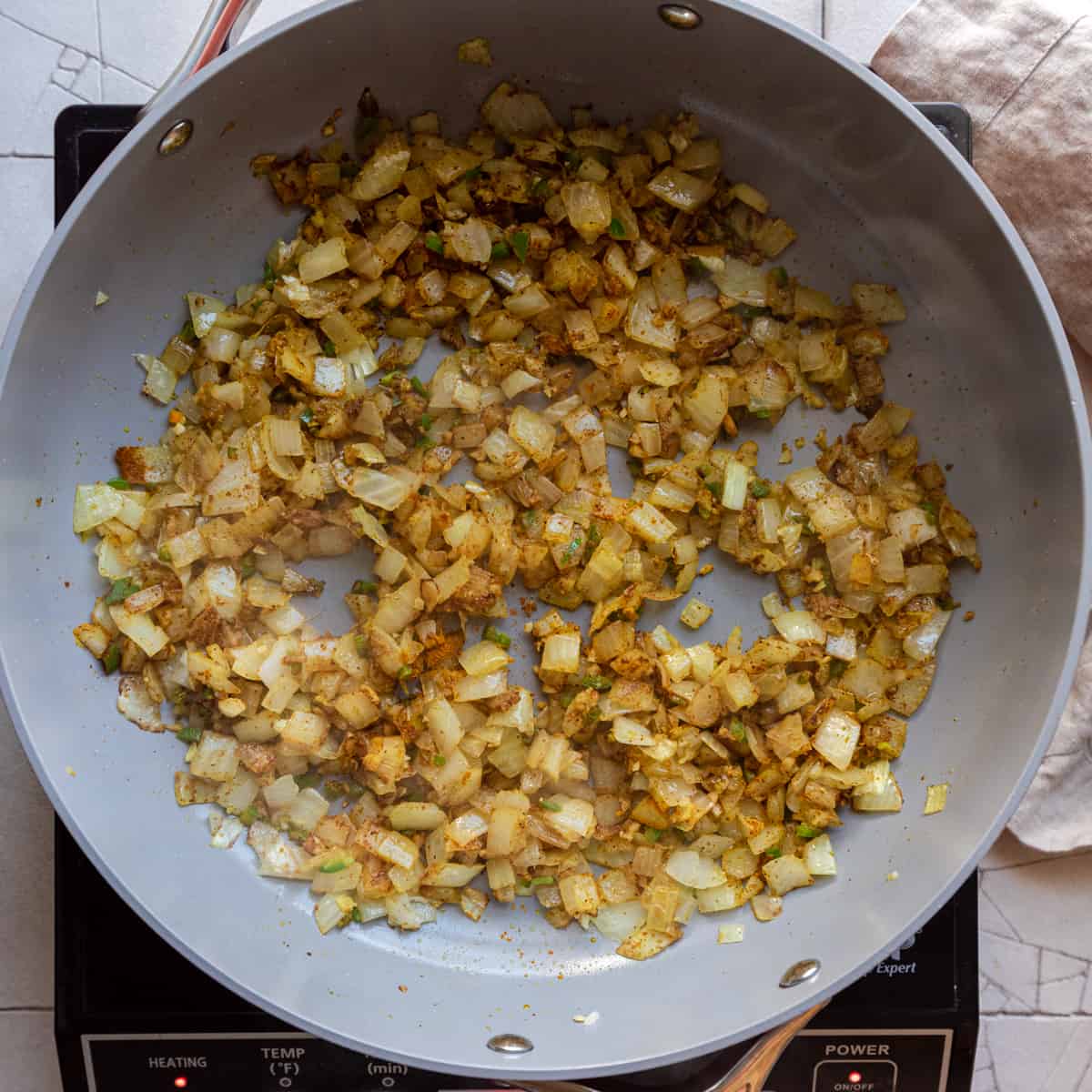
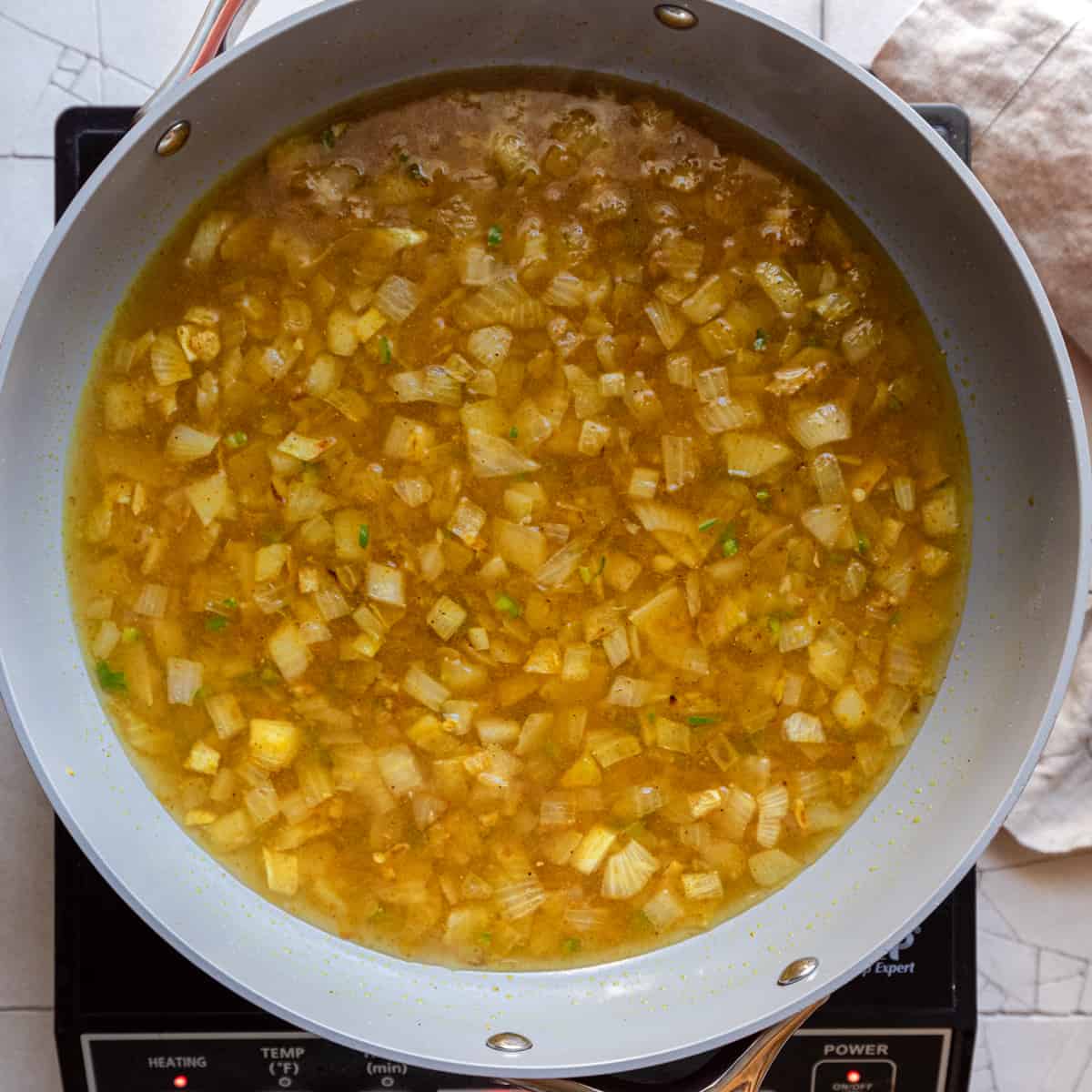
Add the lentils and salt/pepper to the pan. Bring the dal to a boil, then partially cover the pan and reduce the heat to maintain a simmer. Simmer for 30 minutes.
Add the diced tomatoes, stir, and cook uncovered for 4 to 5 minutes, until tomatoes are broken down (fresh tomatoes need more time). At the end, stir in the chopped cilantro.
Tip: for a creamier texture, run an immersion blender through some (but not all) of the dal.
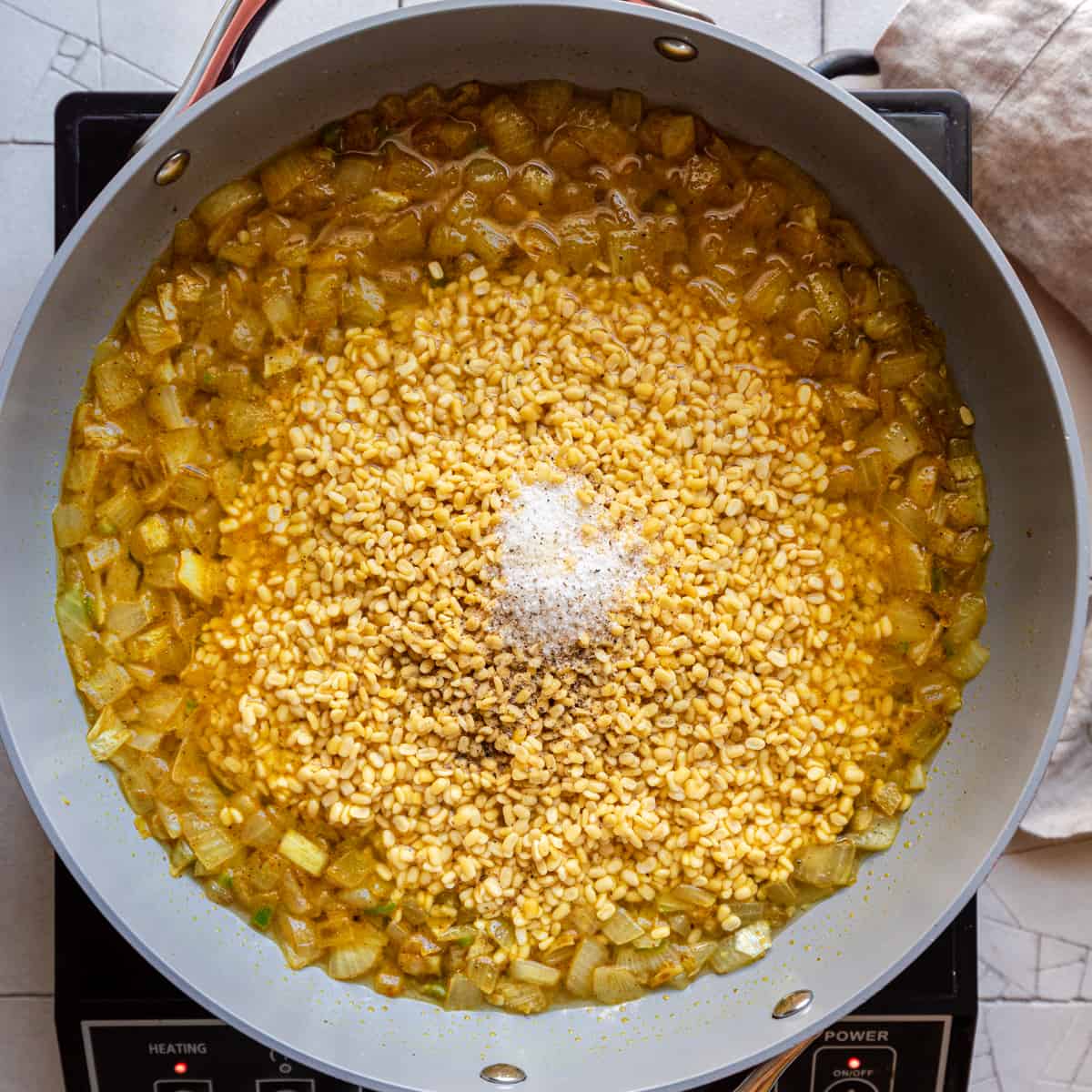
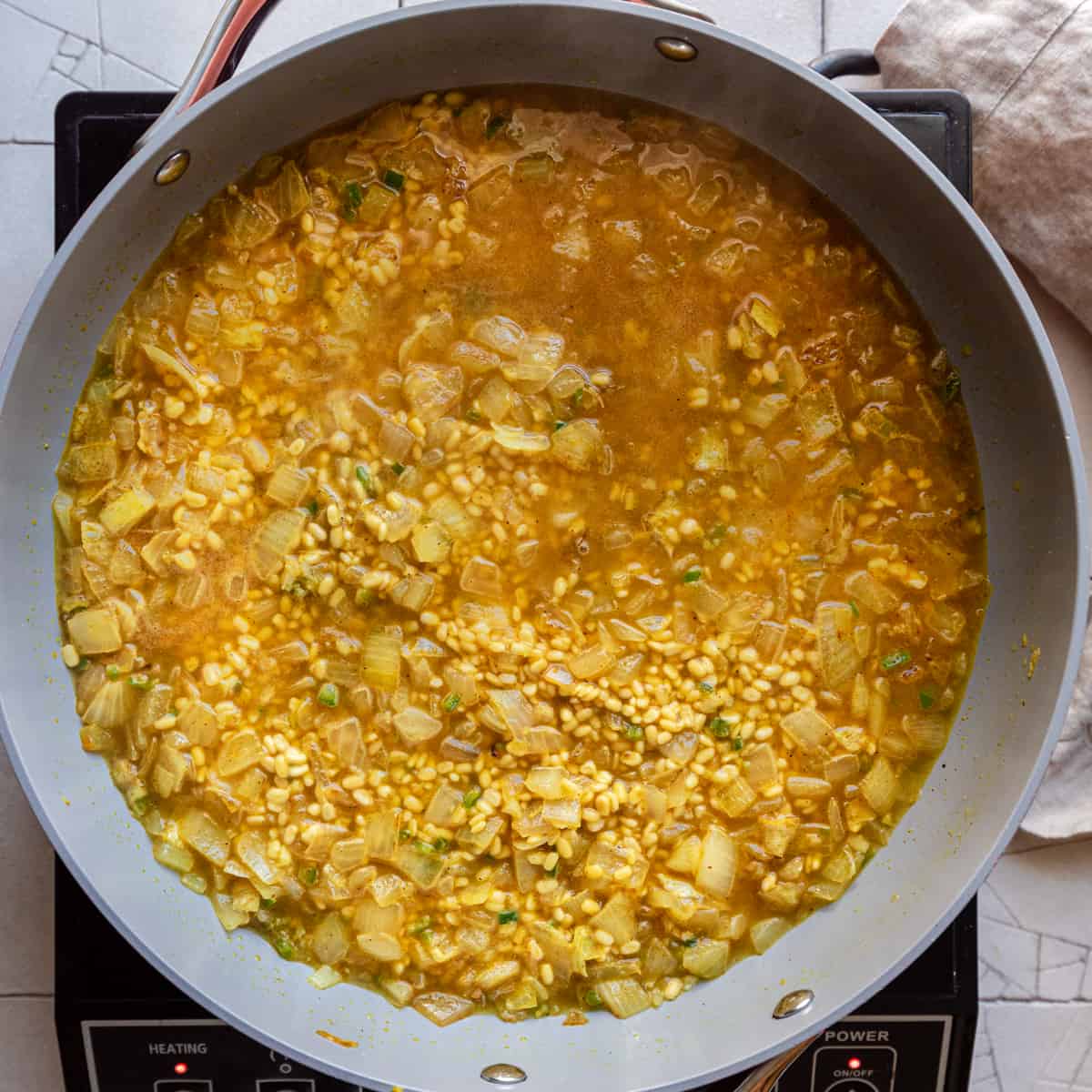
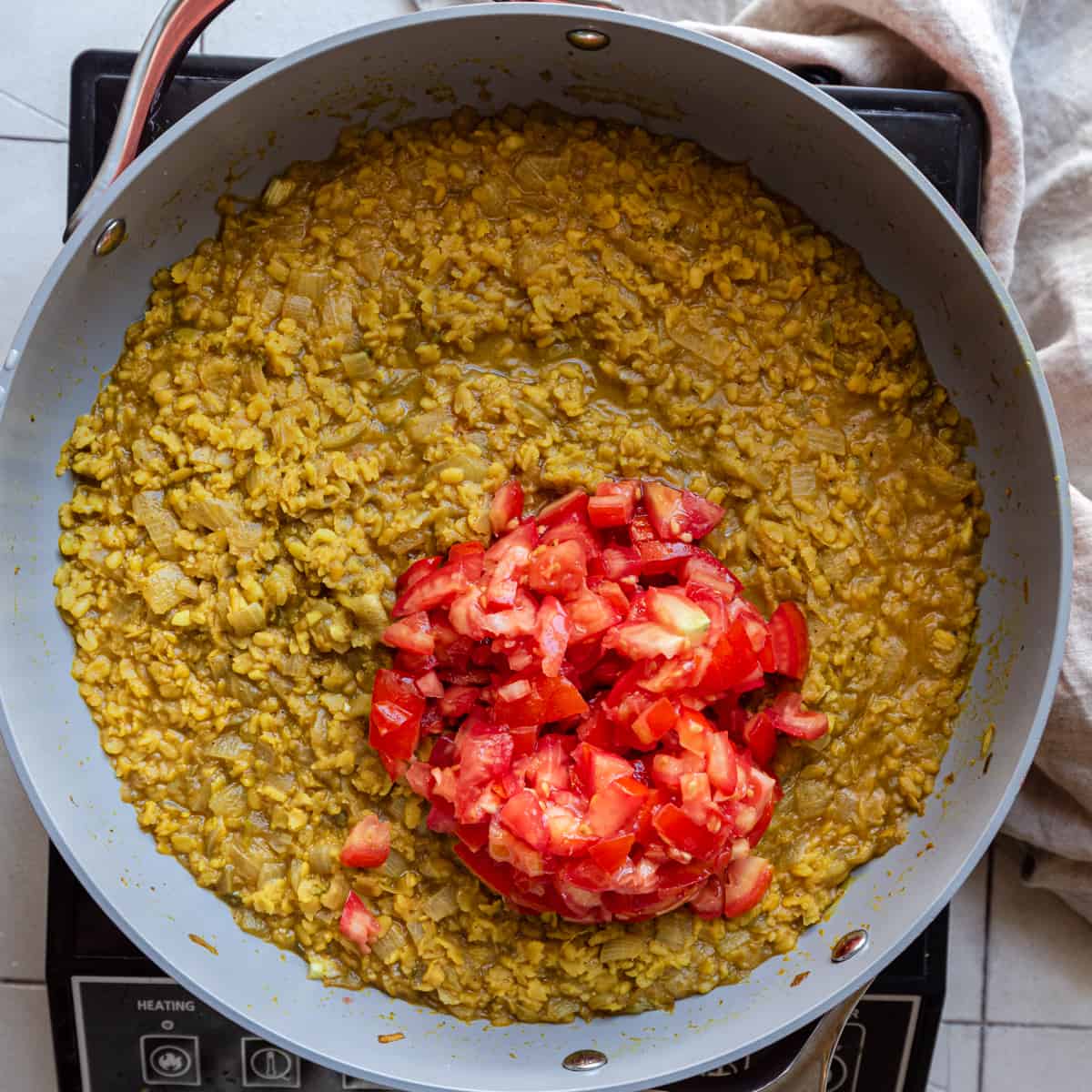
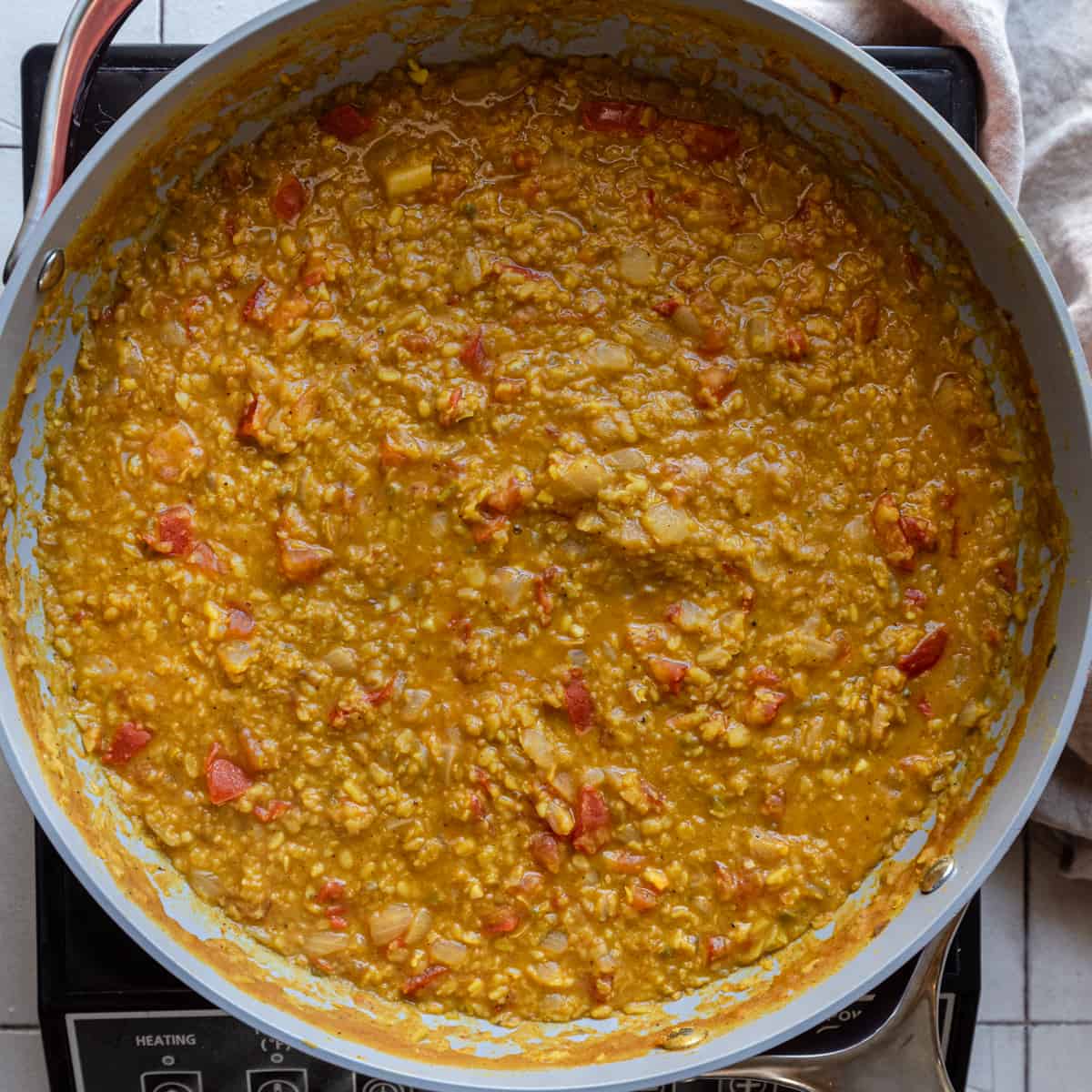
Before serving, make the tadka. Heat a couple spoons of oil up in a tadka pan or small skillet. Once shimmering, add the mustard seeds. Once they pop, add the cumin seeds. Finally, add the curry leaves and dried red chile peppers.
Keep stirring or shaking/swirling the pan to help cook the spices evenly and to prevent burning, for a total of 60-90 seconds.
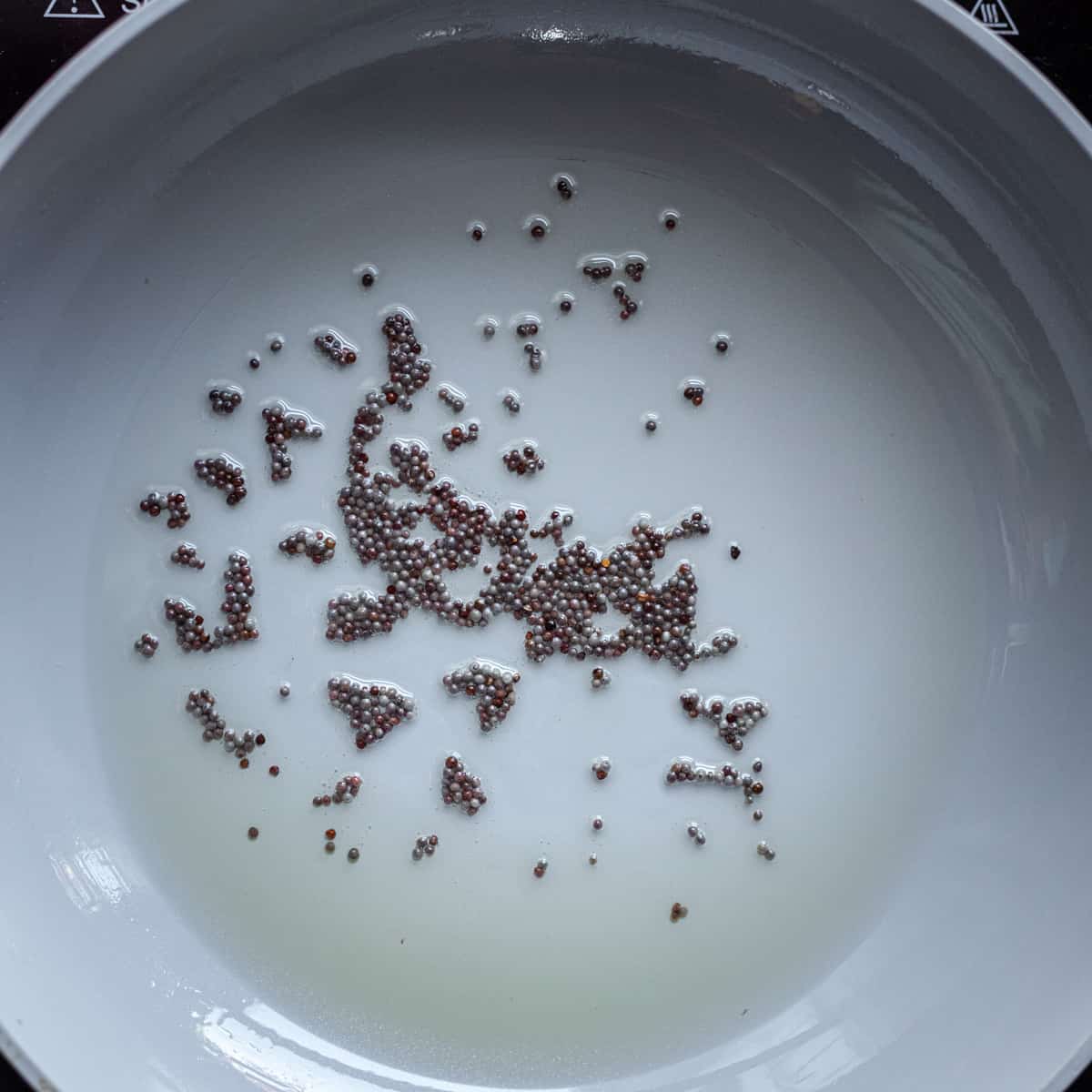
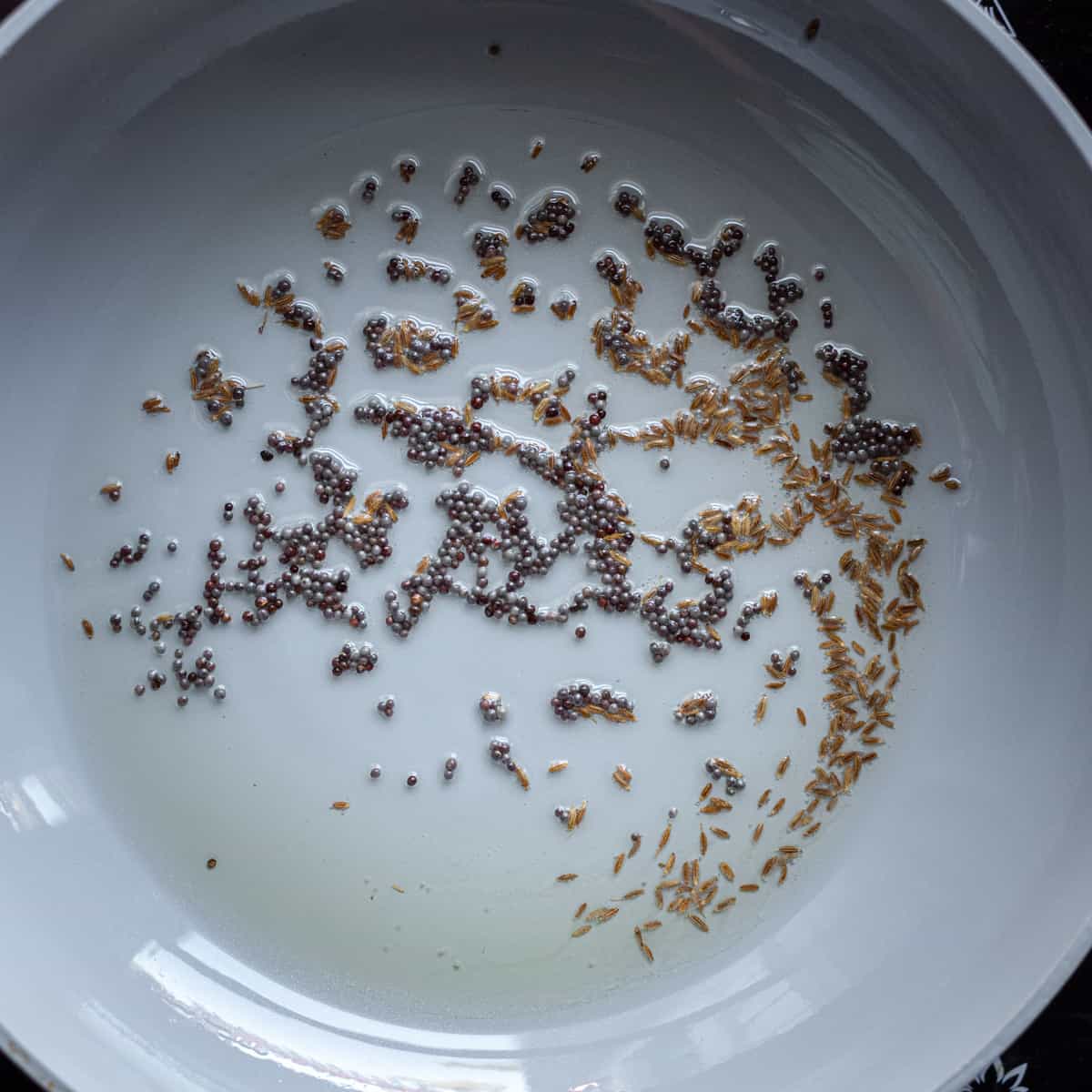
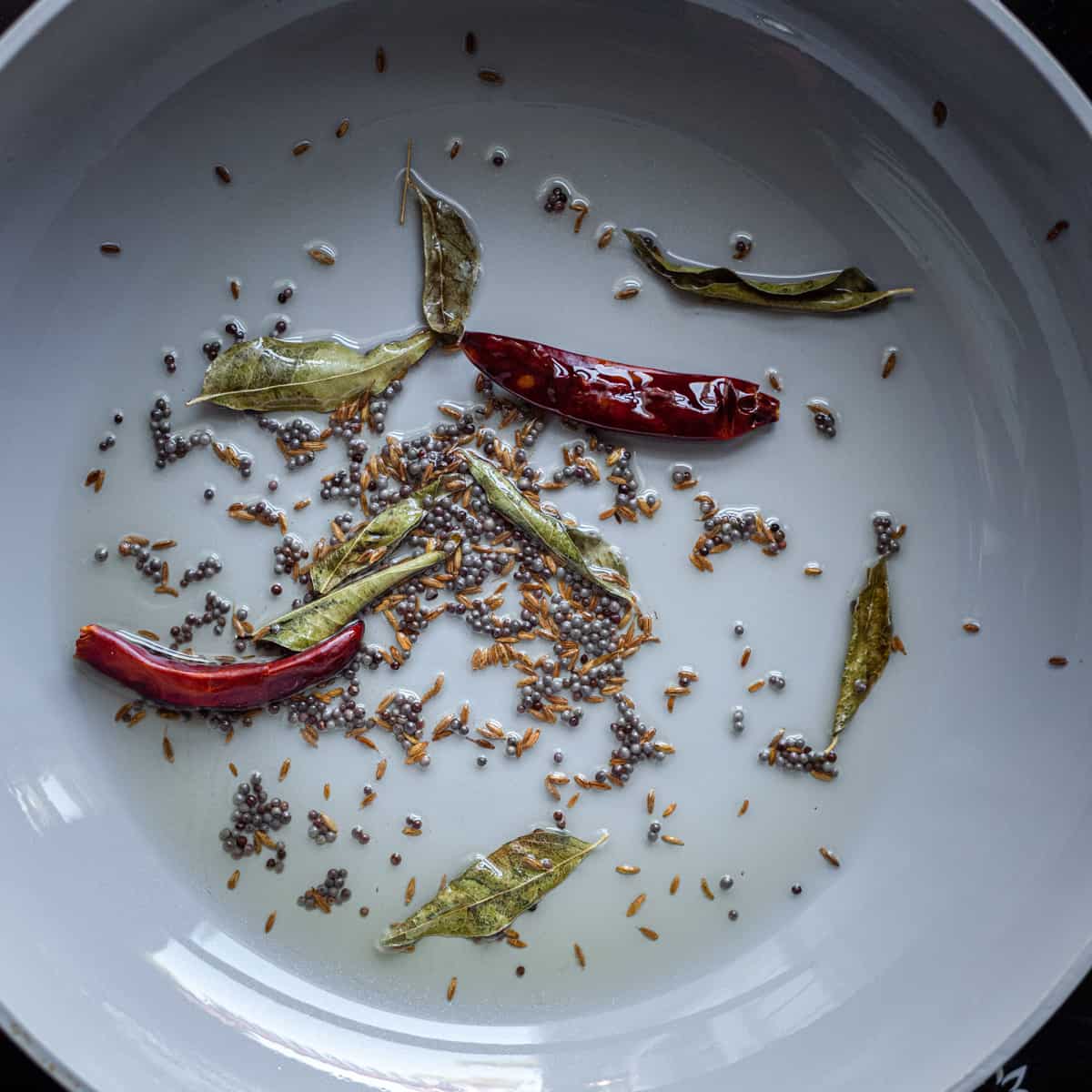
Pour the tadka over the dal and stir to incorporate. Garnish with more cilantro and serve warm!
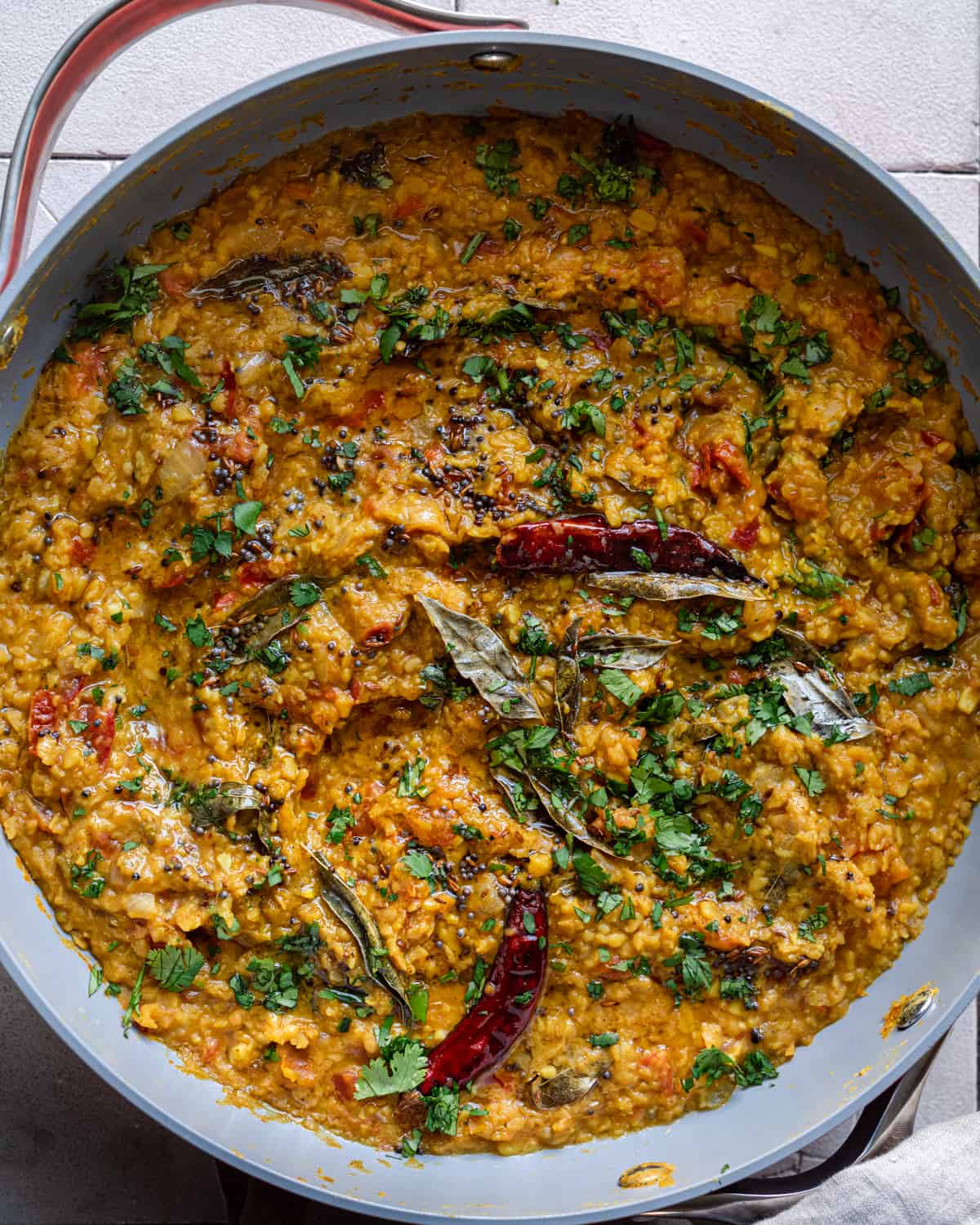
How to make this recipe in the Instant Pot
If you have an Instant Pot, I recommend making dal in the Instant Pot (less hands on cooking and you get a more unctuous consistency).
Reminder: I have an easy dal tadka recipe in my cookbook!
Step 1: Heat the oil in the Instant Pot using the Saute setting (medium heat). Once hot, add the onions and cook until softened. Add the ginger, garlic, green chili and cook for another minute.
Step 2: Add the ground spices for 30 seconds, stirring constantly. Add water as needed if the mixture dries out.
Step 3: Deglaze the pan with the water (I use 2 3/4 cups or 660 mL water). Add the soaked and drained lentils, salt, black pepper, and the diced tomatoes (canned or fresh).
Step 4: Pressure cook at high pressure for 10 minutes. Allow a natural pressure release for 10 minutes.Step 5: Make the tadka on the stove, as indicated in the recipe. Pour the tadka over the finished dal. Finish with cilantro.
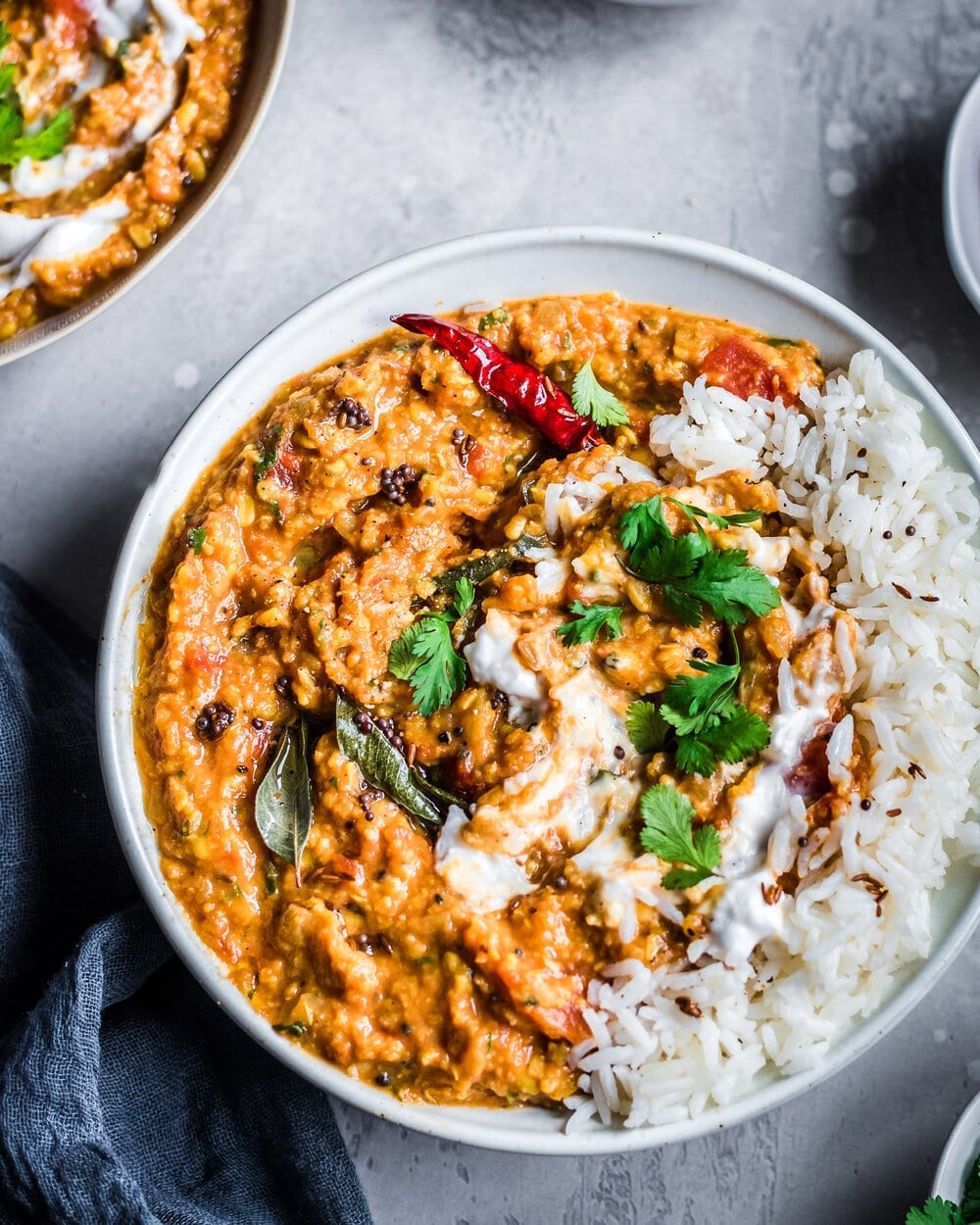
How to serve Dal Tadka
In most Indian families and restaurants, dal is served with either white rice or some sort of simple flatbread, like roti or chapati.
If you are feeling fancy, this dal pairs amazingly well with my homemade Vegan Naan recipe.
For toppings, I like to add a little coconut yogurt and thinly sliced red onion on top. If you don’t have vegan yogurt but still want something cooling, try a little diced avocado. Non-traditional but very good!
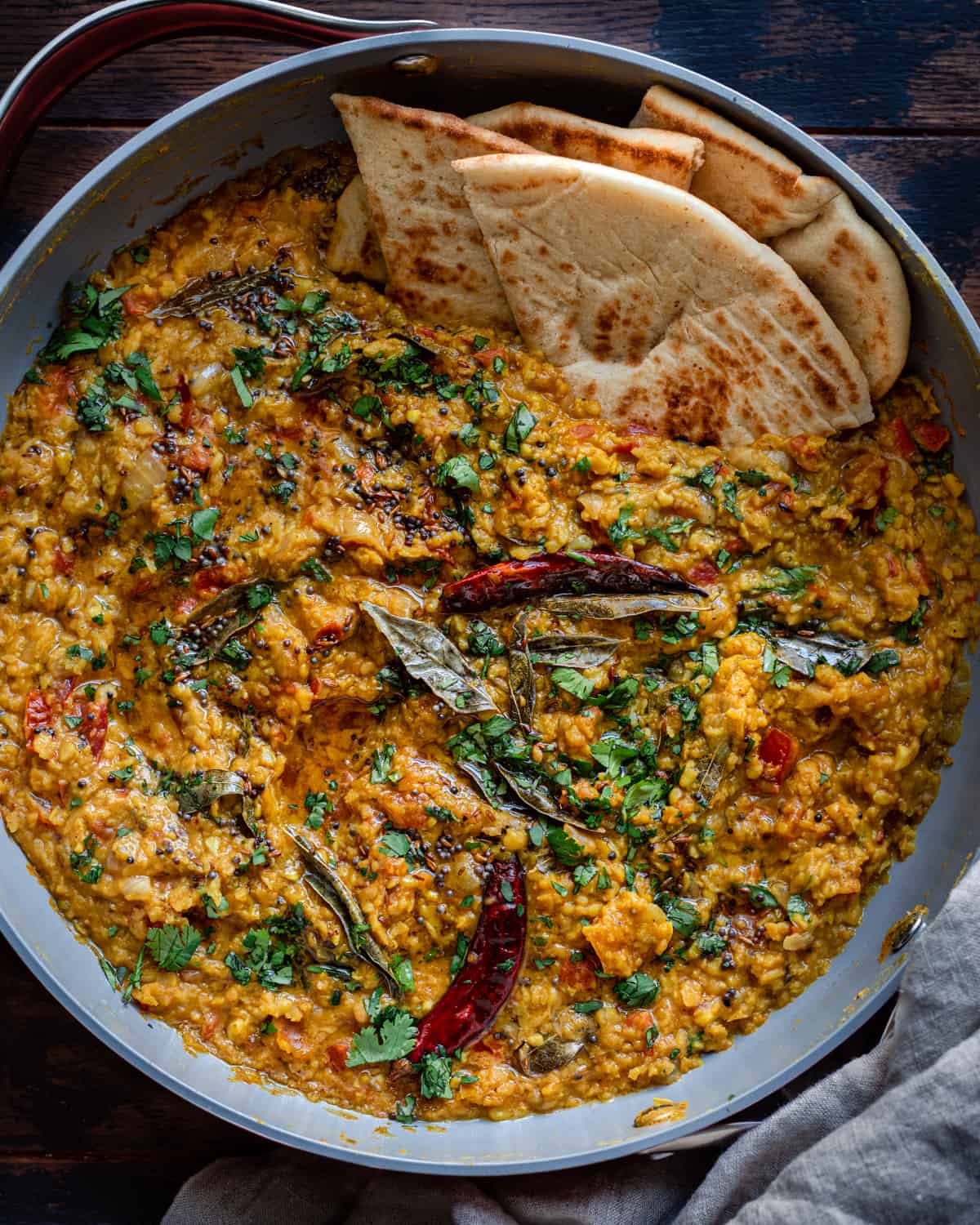
Watch! How to make Vegan Dal Tadka
In the above video, I show you how to make three different lentil recipes. For the Dal Tadka, fast forward to the 3:24 mark. And for more delicious recipe videos, check out my youtube channel!
If you love this recipe, be sure to tag me on Instagram with your recreations and please rate and review the recipe below!
Restaurant-Style Dal Tadka
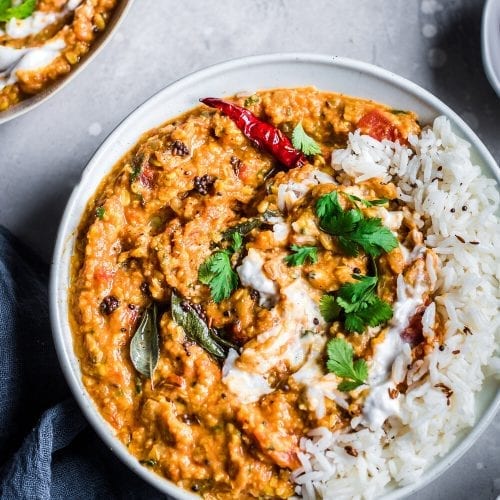
Ingredients
- 1 cup (200g) split yellow lentils, aka “moong dal”*
- 1 tablespoon coconut oil, or neutral oil of choice (more oil needed if not using a nonstick pan)
- 1 medium yellow onion, chopped
- 4 garlic cloves, minced
- 1- inch piece fresh ginger, grated or minced (about 1 tablespoon)
- 1 serrano pepper, diced (remove seeds & membranes for less heat)**
- 1 teaspoon curry powder
- 1 teaspoon garam masala
- 1/4 teaspoon ground coriander
- 1/4 teaspoon ground turmeric
- 2 1/2 – 3 1/2 cups (600 -840 mL) water***
- 1 teaspoon kosher salt, plus more to taste
- Black pepper to taste
- 1 (14.5-ounce / 410g) can diced tomatoes****
- 1 small handful of fresh cilantro, roughly chopped
Tadka
- 1 1/2 – 2 tablespoons coconut oil, or neutral oil of choice
- 1 teaspoon black mustard seeds, can substitute brown mustard seeds
- 1/2 teaspoon cumin seeds
- 5 to 10 fresh curry leaves (10 to 15 dried curry leaves)
- 1-2 dried red chile peppers (optional)
- 1 or 2 pinches asafetida (aka "hing") (optional)
Serving Options
- white basmati rice or Indian flatbread
- vegan coconut yogurt
- fresh cilantro and thinly sliced red onions
Instructions
Directions (Stove-Top)
- Sift through the lentils and remove any pebbles. Soak the lentils in cold water for 15 minutes and then drain them.
- Heat the coconut oil in a heavy, deep frying pan over medium-high heat. Once the oil is shimmering, add the onions and season with a pinch of salt, and cook for 5 to 7 minutes, until softened and starting to turn golden brown on the edges.
- Add the garlic, ginger and serrano pepper. Cook for 60-90 seconds, or until garlic is lightly browned and the mixture is very fragrant. Add the curry powder, garam masala, coriander, and turmeric and stir to coat into the onions, and cook for about 30 seconds, stirring almost constantly.
- Deglaze the pan with the water (I use about 2 cups at this stage), scraping up any browned bits on the bottom of the pan. Add the soaked and drained lentils, 1 teaspoon kosher salt, and black pepper to taste. Stir to combine.
- Bring the dal to a boil. Then lower the heat and partially cover the pan with a lid (if your lid has a small hole on top to allow steam to escape, you can fully cover the pan). Simmer the dal for 30 minutes, or until the lentils are fully cooked through, stirring occasionally and adding more water as needed to add adequate moisture/liquid to the dal.NOTE: Depending on your lentil variety, the cook time might vary from 25 to 35 minutes.
- Add the diced tomatoes and cook for 4-5 minutes, or until they’ve cooked down and are basically blended into the dal. If using fresh tomatoes, cook them until soft and broken down (fresh needs more time than canned). NOTE: If you want the dal to be thicker/creamier, run an immersion blender through some of the dal, but keep some lentils whole. It will also thicken more upon resting. Finally, stir in the chopped cilantro. Taste, adding more salt as needed.
- When the dal is done, make the tadka. Heat a small frying pan or tempering pan over medium heat on the stove. Add the 1 1/2 – 2 tablespoons of the coconut oil and, once it’s hot and shimmering, add the mustard seeds. Once the mustard seeds start popping (30 to 60 seconds), add the cumin seeds for a few seconds. Finally, add the curry leaves, dried red chile peppers (if using) and asafetida (if using). Keep stirring or shaking/swirling the pan to help cook the spices evenly and to prevent burning, 20 to 30 more seconds, or until very aromatic and the curry leaves have shriveled, the chili peppers and cumin seeds have turned darker. Remove from the heat immediately to prevent overcooking.
- Pour the tadka over the dal and stir to combine. If desired, garnish with additional fresh cilantro and taste for seasonings. Serve with white rice and other optional toppings, if desired.
Directions (Instant Pot)
- Sift through the lentils and remove any pebbles. Soak the lentils in cold water for 15 minutes and then drain them.
- Select the Sauté setting on the Instant Pot and let the pot heat up. Add 1 tablespoon of coconut oil or oil of choice, followed by the onion. Cook until the onion is translucent, 3 to 5 minutes.
- Add the garlic, ginger, and serrano pepper, and cook for 1 to 2 minutes, stirring frequently to prevent sticking. Add the Ground Spices and stir to coat into the onions, and cook for about 30 seconds, stirring almost constantly.
- Select the Cancel setting and pour in 2 3/4 cups water, using a wooden spoon to scrape up any browned bits on the bottom of the pot. Add the soaked and drained lentils, 1 teaspoon kosher salt, black pepper to taste, and tomatoes. Stir to combine.
- Secure the lid and set the Pressure Release to Sealing. Select the Pressure Cook setting at high pressure and set the cook time to 10 minutes.
- Once the 10-minute timer has completed, allow a natural pressure release for 10 minutes before manually releasing the steam. Stir the dal. It will thicken more upon resting. Taste, adding more salt as needed.
- While the dal is depressurizing, make the tadka. Heat a small frying pan or tempering pan over medium heat on the stove. Add the 1 1/2 – 2 tablespoons of the coconut oil and, once it’s hot and shimmering, add the mustard seeds. Once the mustard seeds start popping (30 to 60 seconds), add the cumin seeds for a few seconds. Finally, add the curry leaves, dried red chile peppers (if using) and asafetida (if using). Keep stirring or shaking/swirling the pan to help cook the spices evenly and to prevent burning, 20 to 30 more seconds, or until very aromatic and the curry leaves have shriveled, the chili peppers and cumin seeds have turned darker. Remove from the heat immediately to prevent overcooking.
- Pour the tadka over the dal and stir to combine. If desired, garnish with additional fresh cilantro and taste for seasonings. Serve with white rice and other optional toppings, if desired.
Notes





One week ago, I tested positive for Covid-19. As soon as the symptoms hit, I knew I needed to make my favorite dal tadka. I ate it throughout the week, and even though I couldn’t smell or taste it, it helped ease my discomfort. Finally my taste is starting to come back, and I am enjoying another bowl of dal. This is a wonderful recipe that I highly recommend!
We’re glad you’re feeling better, Allison! Covid (or any sickness, really) is no fun at all. It warms our hearts to know this recipe came in handy during a difficult time. Thanks for leaving this review!
Great tasting recipe, pretty easy to put together. The flavor really came together the next day. Nisha, I would appreciate a recommendation on the garam masala that spice is the one that I’m most concerned about getting good flavor from, because I’m not sure how fresh the one I bought was. What brand or brands do you recommend?
Hi Tamlyn, so great to hear you loved the Dal Tadka! And as for the garam masala, we typically use Rani, or Spicewalla on occasion. We haven’t tried this brand, but America’s Test Kitchen recommends McCormick’s garam masala.
I love this quick and easy dal recipe. I’ve made it in the pressure cooker a few times and it alwas tastes great! It tastes even better the next day!
Delicious and easy recipe to make!! I followed the instant pot cookbook instructions and added things from this recipe card (curry leaves). The cookbook has shallots in the tadka and I loved that addition.
Loved this! I subbed green split peas for lentils and skipped the curry leaves, but it was yummy anyway!
That’s so great to hear, Jennifer! Next time, would you mind leaving a rating alongside your review? Star ratings are big help to readers who are thinking of making the recipe. Thanks!
This tastes so good! Thank you for a great recipe.
Hi Cindy, Thank you so much for such a fantastic review! Appreciate you taking the time!
YUM!!! I was skeptical when I tasted this halfway through, but wow the finished result is soooo good! I want to thank you so much. I’ve had Indian food before, of course, and mostly enjoyed it. But, honestly what I’m making at home now from your recipes is so much tastier.
Thank you for your lovely comment, James! It makes us happy to know that you enjoy the recipes.
I believe that moong dal is hulled mung beans not yellow lentils or split peas. I know they all look so similar!
Hi Jessica, yes they fall under the category of Mung Bean but more specifically they’re skinned and split mung beans which are called moong dal or split yellow lentils!
Hi Nisha!
Could you tell me _why_ is tadka done the way it is?
Asking from a perspective of someone who does not like doing more dishes than necessary ^^; :
– the oil and its richness could be there from the start,
– the spices could be there from the start, giving off flavour the whole time,
– they could even be bloomed in hot oil before the rest of the cooking commences, like in some other Indian, non-tadka recipes.
It seems that it might be easier than to get another pan, do the whole warming up thing, blooming the spices carefully as not to burn them, pouring it over the dal, stirring it in, washing the oily tadka pan… Just to do it all in one, especially if it simply gets stirred in at the end.
Hope my question makes sense – I’m both an outsider to tadka, and an outsider to English language :D .
Hi Ana, the reason why tadka is done separately and added to the dish is to enhance the flavor and aroma of the spices and other ingredients. When spices are added directly to a curry or dish, they tend to lose their flavor and aroma as they are cooked for a longer time. By doing tadka separately and adding it at the end, the spices retain their flavor and aroma and add a burst of freshness to the dish. Hope that helped clarify!
Thank you, Kaitlin, it sure did!
I do love encountering and crunching a mustard seed here and there ^_^ .
Awesome! We hope you get the chance to try the recipe :)
I made this recipe today and we really liked it! Thank you for sharing it with us! :)
Hi Ana, we’re so happy you enjoyed this recipe and we’re looking forward to you trying even more! :) Next time, would you mind leaving a rating alongside your review? Star ratings are big help to readers who are thinking of making the recipe.
I made this for dinner tonight. It’s as good, if not better than the one from our favorite Indian restaurant!
We’re delighted to hear you found this Dal Tadka better than the version at your favorite Indian restaurant, Joy. Thanks for your kind words!
This is super tasty and flavorful, wow! Will definitely make this again. I followed recipe entirely besides using avocado oil.
We’re happy to hear it, Eileen! :) Thanks for sharing!
Swoon! My kitchen smells amazing, and dinner was fantastic. This Dal is the best I’ve ever had. Thank You for another outstanding recipe.
This was so simple and incredibly delicious! When I took the first bite I was taken aback at how flavorful it was! 10/10!!
Darien, So glad to hear you’re such a fan of the dal tadka!
Made this tonight for the first time, and just like almost everything I’ve made from your blog since discovering it a year or so ago, it was insanely delicious. The flavour profile is amazing — so much depth. I don’t cook for a family, just for myself, so the recipe will do me for several meals this week. :)
Alanna, So glad to hear you loved this recipe! We’re delighted to hear about the level of trust you have with the RPL recipes :)
Absolutely delicious! It was easy to prepare and the flavors are amazing. This will definitely be a reoccuring meal! Thank you for this recipe!
Nina, So glad to hear you loved this recipe!
Question!! NEED YOUR HELP!!!
I want to know f it’s ok if I let the lentils soak longer then 15 minutes?? I’m handicapped and received some help and it’s my husband that’s gonna finish assemblas and cook the Dahl. I just want a be able to help him! I thank you for your help!
Hi Patricia, yes that’s okay! You can soak them for up to 12 hours. Hope you enjoy it!
I’ve made this twice now and it’s a huge hit with the family (especially my 3yo and 5yo!) we pair with rice and a slice of Naan. I will say that I haven’t put in serrano pepper, curry leaves or asafetida in the Tadka- as I couldn’t find it at the grocery store I shop at, but it’s still delicious! Thanks so much! I love trying to limit our meat dishes and this is a perfect substitute!
I made this today using Chana Dal with the instant pot method and it was so delicious and easy!! Thanks!!
Malissa, So glad to hear you loved this recipe!
Despite some problems with ingredient availability and the substitutions I had to make (the grocery store was out of all hot peppers!), this was absolutely delicious! Non-vegan family, but making the foray so I can be a good host to vegan friends. My hubs literally licked the pan clean. Thanks so much, and looking forward to trying it again with the complete ingredient list.
Awesome, Mel. Thanks for your comment and for taking the time to review!